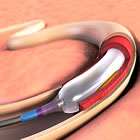|
David Cohen, M.D., M Sc, of Saint Luke's Mid America Heart Institute in Kansas City, Mo., presented the health-economic analysis, demonstrating that IN.PACT Admiral DCB is cost effective in comparison to standard percutaneous transluminal angioplasty (PTA) for the treatment of femoropopliteal artery lesions. Marianne Brodmann, M.D. of Medical University, Graz, Austria, presented real world data from Medtronic's global study for IN.PACT Admiral DCB, where one-year in-stent restenosis (ISR) data showed safety and effectiveness in treating complex ISR lesions. Health-Economic Analysis Establishes Superiority of Medtronic DCB Over PTA "While the index hospitalization costs were approximately $1,100 per patient higher in patients treated with DCB compared to standard PTA, over the two year follow up period, treatment costs were approximately $1,200 per patient less with DCB than standard PTA," said Dr. Cohen. "This net economic advantage for IN.PACT Admiral DCB was driven primarily by the significant reduction in target limb revascularization procedures with DCB over two years of follow up." Overall, the DCB index hospitalization costs were higher compared to PTA ($8,293 vs $7,164, respectively (p=0.03)) but this initial higher cost was offset by a substantial reduction in follow-up costs through two years ($2,984 vs $4,196, respectively (p=0.52)). This led to lower total costs in the DCB arm by the end of two years on top of the significantly lower number of revascularizations in the DCB arm. The follow-up costs included items such as medications, physician fees, outpatient vascular care and repeat hospitalizations. The economic sub-study analysis was carried out from the perspective of the U.S. healthcare system and included 181 U.S. patients in the IN.PACT SFA Trial. The analysis prospectively measured patients' quality of life using the EQ-5D(TM), and assessed the total PAD-related healthcare costs (target limb only) to assess the incremental cost-effectiveness of DCB versus standard PTA in terms of the two year cost per quality-adjusted life-year gained. The study, which was sponsored by Medtronic, was conducted independently by the Mid America Heart Institute's (MAHI) Health Economics and Technology Assessment (HETA) Group. In addition to the base case analysis which found DCB to be economically dominant, a probabilistic sensitivity analysis (PSA) to assess uncertainty of the results demonstrated that IN.PACT Admiral DCB has a high probability of being economically attractive (ICER<$50,000 QALY) compared to standard PTA, thereby increasing confidence in the robustness of the analysis. The results from this economic analysis support the positive reimbursement decisions that many healthcare payers around the world have made who are covering this therapy for their populations. In the U.S., for example, the superior effectiveness of IN.PACT Admiral DCB was recognized by the U.S. Centers for Medicare and Medicaid Services (CMS) with the approval, earlier this year, of both hospital outpatient and inpatient new technology add-on payments to support access to DCB therapy. One-Year Outcomes from the IN.PACT Global Study Demonstrate Effectiveness in Complex ISR Lesions in the SFA Complex lesion types, including long lesions, chronic total occlusions and ISR, remain challenging to treat with no identified current treatment standards. ISR is estimated to occur in 30 to 40 percent of all stents placed in the SFA. Treatment with standard PTA techniques is associated with poor patency outcomes. The one-year primary patency rate for this difficult to treat patient subgroup was 88.7 percent, and the CD-TLR rate was a low 7.3 percent, especially considering the mean lesion length of 17.2 + 10.5 cm. "Results demonstrate effectiveness and safety of the IN.PACT Admiral DCB in the treatment of patients with complex SFA lesions, including challenging ISR lesions," said Dr. Brodmann. "The primary patency is unmatched in this difficult to treat patient subgroup." "IN.PACT Admiral DCB is a proven primary therapy for SFA disease. The latest clinical results demonstrating consistency, safety, efficacy and cost-effectiveness will continue to drive a paradigm shift in SFA interventions," said Brian Verrier, vice president and general manager of the Peripheral franchise, within the Aortic and Peripheral Vascular business at Medtronic. "Another key pillar of Medtronic's mission is the ongoing pursuit of providing solutions which increase economic value within the healthcare system. We are proud to showcase our commitment to improving outcomes and increasing economic value through IN.PACT Admiral DCB." Medtronic will host symposia to provide further analysis and discussion on DCB treatment in the SFA and the impact on patient outcomes at VIVA 2015 this week.
In collaboration with leading clinicians, researchers and scientists worldwide, Medtronic offers the broadest range of innovative medical technology for the interventional and surgical treatment of cardiovascular disease and cardiac arrhythmias. The company strives to offer products and services that deliver clinical and economic value to healthcare consumers and providers around the world.
About IN.PACT Admiral Drug-Coated Balloon IN.PACT Admiral DCB received the CE (Conformité Européene) mark in 2009 and approval by the U.S. Food & Drug Administration in December 2014. It is the most studied drug-coated balloon to-date. Medtronic is conducting four Medtronic-sponsored studies, which include IN.PACT SFA, IN.PACT Global, IN.PACT Japan and IN.PACT China, to assess the safety and effectiveness of the IN.PACT Admiral DCB. In addition, Medtronic is supporting approximately 20 physician-initiated DCB studies. In total, data on more than 4,000 patients treated with the IN.PACT Admiral DCB will be available. About Medtronic * IN.PACT® Admiral® drug-coated balloon (DCB) is not indicated for ISR use in the U.S. Any forward-looking statements are subject to risks and uncertainties such as those described in Medtronic's periodic reports on file with the Securities and Exchange Commission. Actual results may differ materially from anticipated results. Source: Medtronic plc |


